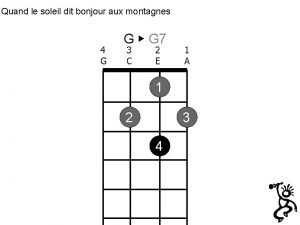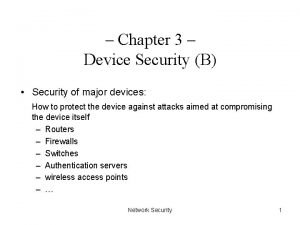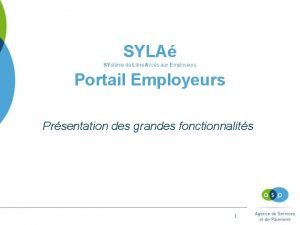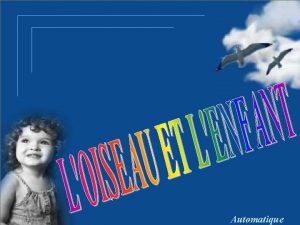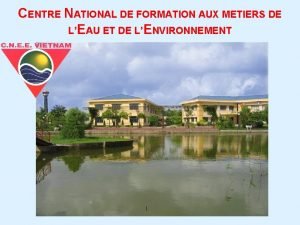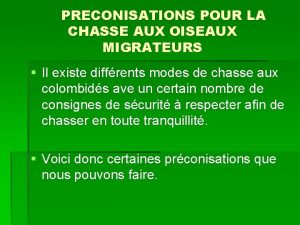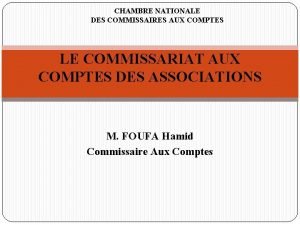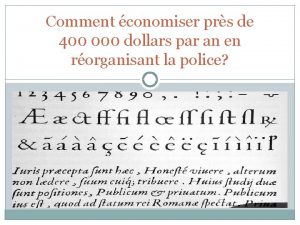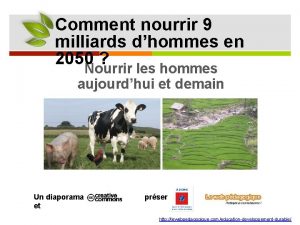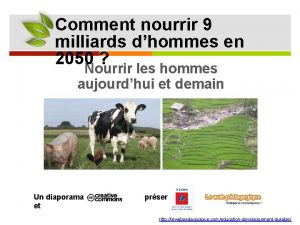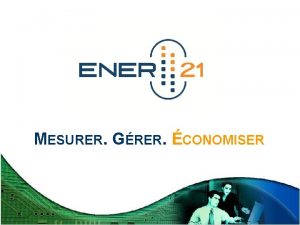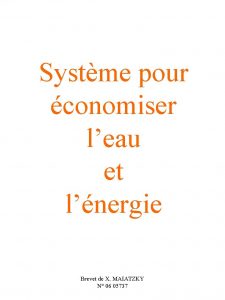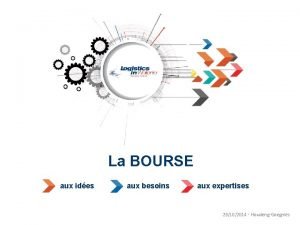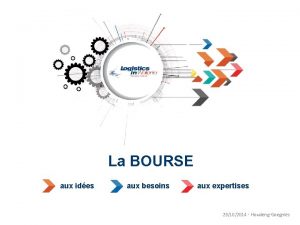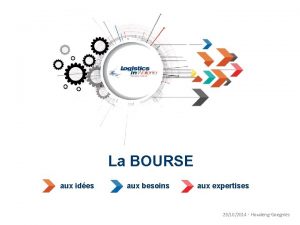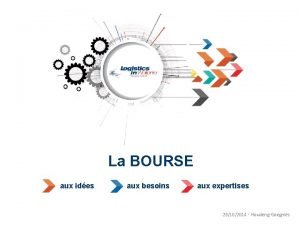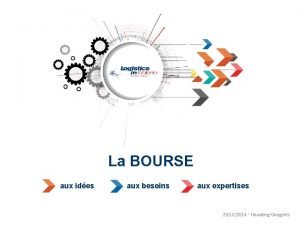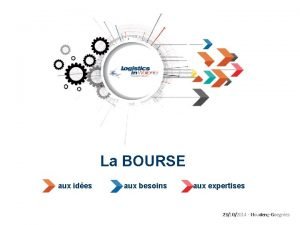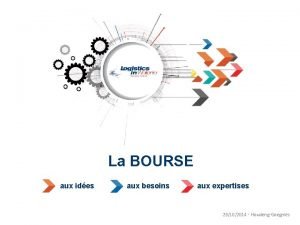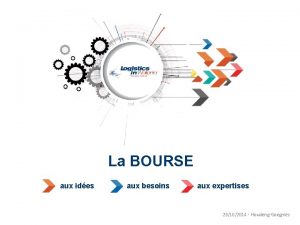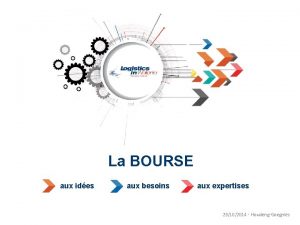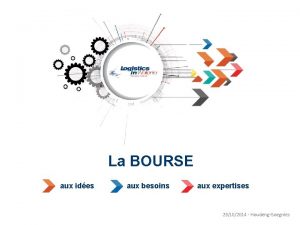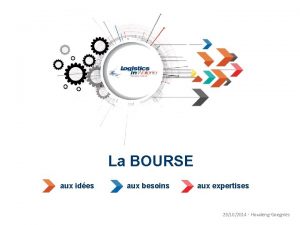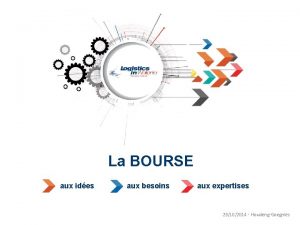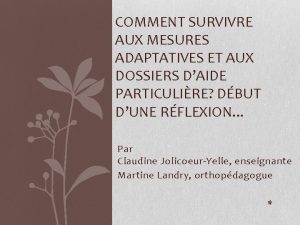COMMENT CONOMISER 2 MILLIARDS DEUROS GR CE AUX

























- Slides: 25

COMMENT ÉCONOMISER 2 MILLIARDS D’EUROS GR CE AUX USP? PATINS RÉDUCTEURS D’ATTRITION (USP) 21/02/2021 Produits FIMOR pour Infrastructure Ferroviaire 1

PRODUITS POUR INFRASTRUCTURES FERROVIAIRES PROTECTIONS POUR ROUES CALES D’ARRÊT SOLUTIONS ANTI-BRUIT POUR BALLASTIÈRES Copyright : FIMOR SELLES ANTI-VIBRATILES 21/02/2021 Produits FIMOR pour Infrastructure Ferroviaire 2

NORMES INTERNATIONALES P US f. Ré de pe y P T US A (USP) Dur / Moyen M Moyen r u ide Ra n tio ce de a r o n éli nan tio ec ast Am ainte étrie t o m m Pr ball la géo ail e du r d la du 0. 25 N/mm 3≤C stat<0. 3 5 N/mm 3 0. 15 N/mm stat<0. 2 5 N/mm 3 3≤C 0. 10 N/mm stat<0. 1 5 N/mm 3 S Moyen/ Souple 3≤C V Souple/ Très souple Cstat<0. 10 N/mm 3 + + + + = = - n tio nu re i Dim l’usu ire de ulato d on = = + + + ils are e p Ap voi de + + = - on s cti ts u u d rbe Ré défa ires Cou ées s rr de ulato se d on = = + + + e tur uc str ra Inf ++ Application antiattrition disponible sur plateforme standard = USP pour zone de transition ou pour contrôler la raideur des plateformes standard - Utilisation partiellement antivibratile sur structure rigide, ou pour les zones de transition - Utilisation antivibratile pour structure rigide (tunnels, ponts…) Sources : Réseau Ferré de France & UIC 21/02/2021 Produits FIMOR pour Infrastructure Ferroviaire 3

FONCTION PRINCIPALE DES USP POURQUOI UTILISER LES USP? Ø SANS USP: estimation de la surface en contact => 2 - 3 % de la surface inférieure de la traverse Ø AVEC USP: surface en contact estimée entre 10 et 35 % selon la catégorie d’USP CC BY-SA 3. 0 de 21/02/2021 Produits FIMOR pour Infrastructure Ferroviaire 4 Copyright : FIMOR USP

LES BÉNÉFICES DES USP (A) SELON UN RÉCENT RAPPORT DE L’UIC, LES BÉNÉFICES DES USP SONT MULTIPLES (ET LIÉS): • Meilleure répartition de la charge sur la traverse • Raideur plus uniforme • Meilleure stabilité de la géométrie de la voie • Réduction du nombre de bourrage par un facteur 3 • Prévention des traverses “suspendues” • Prolongation de la durée de vie des traverses • Réduction de l’usure ondulatoire • Amélioration globale du Coût du Cycle de Vie (LCC) 21/02/2021 Produits FIMOR pour Infrastructure Ferroviaire CC BY-SA 3. 0 de CC-BY-SA-2. 5, 5 Copyright : FIMOR • Réduction de la hauteur du ballast (10 cm)

LES BÉNÉFICES DES USP (B) SELON UNE ÉTUDE DE L’UNIVERSITÉ DE SOUTHAMPTON, LES USP AMÉLIORENT LA PERFORMANCE DES VOIES BALLASTÉES AU NIVEAU DES APPAREILS DE VOIES • Augmentation du nombre de zones de contact entre la traverse et le ballast • Réduction de la raideur du support (appareil de voie) et répartition de la charge sur un plus grand nombre de traverses • Réduction des variations de raideur CC-BY-SA-2. 5, 21/02/2021 Produits FIMOR pour Infrastructure Ferroviaire 6 Copyright : FIMOR CC BY-SA 3. 0 de

RETOUR D’EXPERIENCE SNCF - PRA Après 15 ans de mise en service de traverses équipées de PRA sur deux LGV principales, la SNCF a publié des résultats sur la réduction du taux de bourrage et l’amélioration du nivellement longitudinal de la voie. LGV MED : LYON-MARSEILLE 21/02/2021 LGV NORD : PARIS-LILLE Fimor Products for Track Superstructure 7

RETOUR D’EXPERIENCE SNCF – PRA – LGV MED V 1 Voie standard 35 cm de ballast 320 km/h 581+824 V 1 Voie sur dalle + 25 cm de ballast sans USP 320 km/h / 300 km/h 586+850 866+000 25 cm de ballast + USP 320 km/h Taux de bourrage 670+200 685+200 35 cm de ballast + USP 687+400 Voie sur dalle + 25 cm de ballast + USP 320 km/h / 300 km/h 270 km/h / 300 km/h 270 km/h Sans USP LN 5 V 1 270 km/h / 300 km/h USP 18, 91% Sans USP 320 km/h USP 44, 07% Sans USP 72, 50% V 1 581, 824 / 586, 850 VAX U 41 avec 25 cm ballast 29, 47% V 1 666, 000/670, 200 VAX U 41 avec 35 cm ballast 31, 24% 20, 35% 152, 16% 16, 71% V 1 685, 200/687, 400 slab track + VAX U 41 avec 25 cm ballast 3, 96% 1, 67% 58, 61% 31, 78% 19, 91% Copyright : SNCF RESEAU 21/02/2021 Fimor Products for Track Superstructure 8

RETOUR D’EXPERIENCE SNCF – PRA – LGV MED NL : Nivellement Longitudinal (mm) Copyright : SNCF RESEAU 21/02/2021 Fimor Products for Track Superstructure 9

RETOUR D’EXPERIENCE SNCF – PRA – LGV NORD V 1 (216 000) Voie standard 320 km/h / 300 km/h 80+080 78+460 V 1 (216 000) VAX U 41 avec USP 300 km/h Taux de bourrage 300 km/h Sans USP LN 3 V 1 216 000 46, 60% 216 000 V 1 78, 460/80, 080 VAX U 41 44, 79% USP 21, 21% Copyright : SNCF RESEAU 21/02/2021 Fimor Products for Track Superstructure 10

RETOUR D’EXPERIENCE SNCF – PRA – LGV NORD NL : Nivellement Longitudinal (mm) Copyright : SNCF RESEAU 21/02/2021 Fimor Products for Track Superstructure 11

RETOUR D’EXPERIENCE SNCF - PRA CONCLUSION : => Réduction du taux de bourrage de 50%. => Amélioration du nivellement longitudinal de 50%. 21/02/2021 Fimor Products for Track Superstructure 12

ZONES D’UTILISATION DES USP (A) IMPACT SUR LA GÉOMÉTRIE DE LA VOIE: EXPÉRIENCE EN AUTRICHE niveau longitudinal gauche niveau longitudinal droit mesuré avec le wagon de mesure EM 250: 01. 07. 2004 23 MGT/an SPD. max=120 km/h Cycle de bourrage: 5 ans USP: 10 ans Zone équipée d‘USP sd-010704 sd_011103 sd_100303 sd_290802 sd_110402 sd_071101 sd_270901 détérioration de la qualité de la géométrie de la voie (niveau longitudinal) Zone équipée d‘USP 21/02/2021 Produits FIMOR pour Infrastructure Ferroviaire 13 Copyright : UIC CC BY-SA 3. 0 de

ZONES D’UTILISATION DES USP (B) IMPACT SUR LA GÉOMÉTRIE DE LA VOIE: EXPÉRIENCE EN FRANCE (Avec autorisation de M. Antoni, SNCF) Ligne à grande vitesse – 320 km/h Opérations de maintenance (bourrage/meulage) 667. 000 668. 000 666. 500 667. 500 666. 000 667. 000 Indice de dégradation de la voie (écart standard du nivellement) 2 2 1 1 2001 0 2013 2001 2013 Du Km 666 au Km 667, sans USP : 20 opérations de bourrage pour NL 1. 3 Du Km 667 au Km 668, avec USP : 4 opérations de bourrage pour NL 0. 6 21/02/2021 Produits FIMOR pour Infrastructure Ferroviaire 14 Copyright : UIC 0

NORMES SNCF : TESTS GÉNÉRAUX LES COMPORTEMENTS MÉCANIQUES ET CHIMIQUES DES USP SONT RIGOUREUSEMENT VÉRIFIÉS Tests climatiques (traverses + USP) Copyright : FIMOR Tests de raideur dynamique sur des blocs de 250 x 250 mm 21/02/2021 Produits FIMOR pour Infrastructure Ferroviaire 15

NORMES SNCF : RÉSISTANCE À L’ARRACHEMENT (A) Depuis le premier brevet (SNCF/SERP 1989), la principale problématique des USP a toujours été la résistance à l’arrachement. Tout a été testé: 1. Des pierres dans le caoutchouc, puis dans le béton, 3. Et notre modèle à unique entièrement en PU, avec rivets anti-extraction. 21/02/2021 Produits FIMOR pour Infrastructure Ferroviaire 16 Copyright : FIMOR 2. Une grille géotextile, également appliquée dans le caoutchouc, puis dans la traverse,

NORMES SNCF : RÉSISTANCE À L’ARRACHEMENT (B) : FORCE Copyright : FIMOR FILM DU TEST DE RÉSISTANCE À L’ARRACHEMENT DU PATIN FIMOR DANS UN BLOC DE BÉTON 21/02/2021 Produits FIMOR pour Infrastructure Ferroviaire 17

NORMES SNCF : RÉSISTANCE À L’ARRACHEMENT (C) Le système d’accroche des USP est très important durant la manipulation des traverses. Copyright : FIMOR Nous recommandons un système d’accroche avec une insertion de plusieurs millimètres dans le béton afin d’atteindre une durée de vie de 50 ans. 21/02/2021 Produits FIMOR pour Infrastructure Ferroviaire 18

NORMES SNCF : RÉSISTANCE À L’ARRACHEMENT (D) Copyright : FIMOR Notre système d’accroche est compatible avec différents types de bétons (sec et/ou humide) et avec plusieurs processus de fabrication de traverses (démoulage immédiat et démoulage continu) 21/02/2021 Produits FIMOR pour Infrastructure Ferroviaire 19

NORMES SNCF : TESTS DE FATIGUE JUSQU’À PRÉSENT, LA FRANCE EST LE SEUL PAYS À TESTER LE VIEILLISSEMENT ACCÉLÉRÉ DES PATINS DANS DES CONDITIONS RÉELLES (RÉSISTANCE À L’USURE) Copyright : FIMOR Durée cumulée de la charge dynamique: 36 millions de cycles (=> ± 10 ans de passage de trains). Fréquence : 50 Hz. Les USP serilor ® après le test “VIBROGIR” 21/02/2021 Produits FIMOR pour Infrastructure Ferroviaire 20

ÉTUDE DE RENTABILITÉ NOUS SOMMES EN 2015 ET NOUS AVONS DÉCIDÉ DE CONSTRUIRE UNE NOUVELLE LGV DE 300 KM CAS 1 : “Trafic faible” et vitesse < 200 km/h Trafic fort 25 CAS 2 : “Trafic moyen” et/ou 200 km/h< vitesse < 280 km/h et/ou convois mixtes Trafic moyen 10 Trafic faible CAS 3 : “Trafic fort” et/ou vitesse >280 km/h et/ou convois mixtes à trafic moyen et fort 5 0 Vitesse Km/h 200 280 320 Copyright : FIMOR Charge Mt/an TRAFIC FAIBLE = <10 Mt/an et <200 km/h TRAFIC MOYEN = 10 -25 Mt/an et/ou 200 km/h à 280 km/h TRAFIC FORT = >25 Mt/an et/ou 280 km/h to 320 km/h et/ou convois mixtes (ALSTOM et SIEMENS) 21/02/2021 Produits FIMOR pour Infrastructure Ferroviaire 21

DÉPENSE ESTIMÉE DONNÉES D’ENTRÉE SUR UNE PÉRIODE DE 50 ANS POUR UNE LGV (PAR VOIE SIMPLE) Dépense estimée pour l’utilisation de USP (2 par traverse), montage inclus: 30 000€/km/voie 1. Coût moyen du bourrage (BML): 7, 50 €/mètre Fréquence des BML sans USP : Trafic fort = tous les 2 ans / Trafic moyen = 3 ans / Trafic faible = 5 ans 2. Coût moyen du renouvellement du ballast (RB): 110 €/mètre Fréquence des RB sans USP: Trafic fort = à la 25ème année / Trafic moyen = à la 40ème année/ Trafic faible = jamais 3. Coût moyen du renouvellement des voies ballastées (RVB): 1200 €/mètre (par rail) Fréquence des RVB sans USP: Trafic fort = à la 40ème année / Trafic moyen = jamais / Trafic faible = jamais 4. Grâce aux USP, les coûts de maintenance sont en moyenne réduits par un facteur 3 (Source : RFF/SNCF résultats du rapport sur la LGV LYON-MARSEILLE). 21/02/2021 Produits FIMOR pour Infrastructure Ferroviaire Copyright : FIMOR 1. 22

COÛT DU CYCLE DE VIE DES USP ET DE LA VOIE (A) RETOUR SUR INVESTISSEMENT DES USP (300 Km) PAR VOIE SIMPLE RETOUR SUR INVESTISSEMENT SUR LES COÛTS DE MAINTENANCE EN MILLIONS D’EUROS 0 3 5 7 15 25 50 Trafic faible -4, 1 -2, 6 0, 5 3, 5 9, 5 Trafic moyen -4, 1 -2, 6 -1, 1 3, 5 8, 0 42, 0 Trafic fort -4, 1 -2, 6 -1, 1 0, 5 6, 5 30, 5 228, 5 Trafic faible -4, 1 -2, 3 -1, 5 -0, 2 35, 2 Trafic moyen -4, 1 -2, 4 -0, 6 6, 4 16, 3 169, 9 Trafic fort -4, 1 -2, 5 -0, 8 1, 0 9, 9 68, 1 975, 7 Avec un taux d’inflation standard de 4% sur la maintenance 21/02/2021 Produits FIMOR pour Infrastructure Ferroviaire 23 Copyright : FIMOR Années Sans inflation sur la maintenance

COÛT DU CYCLE DE VIE DES USP ET DE LA VOIE (B) RETOUR SUR INVESTISSEMENT DES USP (300 Km) TAUX D’INFLATION +4% ANNUELS 550. 0 Trafic faible Trafic fort Trafic moyen 450. 0 350. 0 Courbes lissées après 5 – 10 – 25 – 50 ans 250. 0 150. 0 - 50. 0 0 21/02/2021 5 10 15 20 25 30 35 40 45 Copyright : FIMOR Millions d’€ Retour sur investissement après 5 ans 50 Années Produits FIMOR pour Infrastructure Ferroviaire 24

CONCLUSION 21/02/2021 Produits FIMOR pour Infrastructure Ferroviaire Copyright : FIMOR 4 CONCLUSIONS QUESTIONS ? 25
 Rembrandt aux yeux hagards
Rembrandt aux yeux hagards Ne fait pas aux autres ce que tu n'aimerais
Ne fait pas aux autres ce que tu n'aimerais Quand le soleil dit bonjour aux montagnes
Quand le soleil dit bonjour aux montagnes Example of loopback address
Example of loopback address Je peux aller aux toilettes s'il vous plait
Je peux aller aux toilettes s'il vous plait Rosenkavalier meaning streetcar
Rosenkavalier meaning streetcar Sophisme pétition de principe
Sophisme pétition de principe Syla asp
Syla asp Traduire
Traduire Comme un enfant aux yeux
Comme un enfant aux yeux Il sauva daniel de la fosse aux lions
Il sauva daniel de la fosse aux lions Np aux vp
Np aux vp Lisez le texte puis répondez aux questions
Lisez le texte puis répondez aux questions Centre national de formation aux métiers de l'eau
Centre national de formation aux métiers de l'eau Crrpi
Crrpi Partition ouvre mes yeux, seigneur, fais que je vois
Partition ouvre mes yeux, seigneur, fais que je vois Bulgarie aux jeux olympiques d
Bulgarie aux jeux olympiques d Pompe aux pommes
Pompe aux pommes Ressorts complets pour pantes palombes ou alouettes
Ressorts complets pour pantes palombes ou alouettes Chant alleluia christ est vivant
Chant alleluia christ est vivant Aux armes citoyens
Aux armes citoyens Dans ces murs voués aux merveilles
Dans ces murs voués aux merveilles Lisez le texte et répondez aux questions
Lisez le texte et répondez aux questions Chambre nationale des commissaires aux comptes
Chambre nationale des commissaires aux comptes Chere parents
Chere parents Fais correspondre
Fais correspondre


